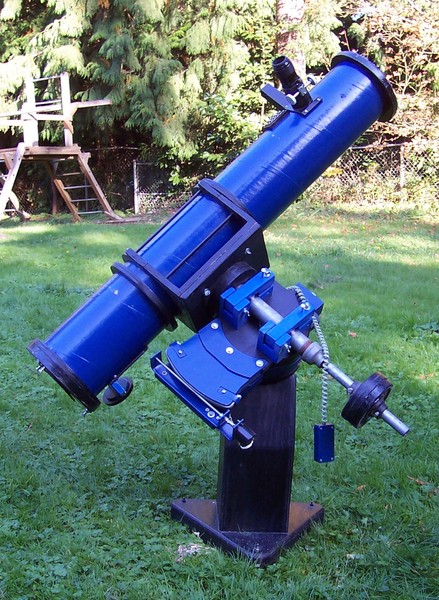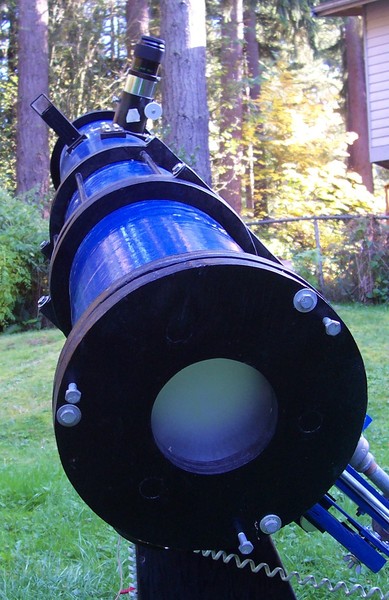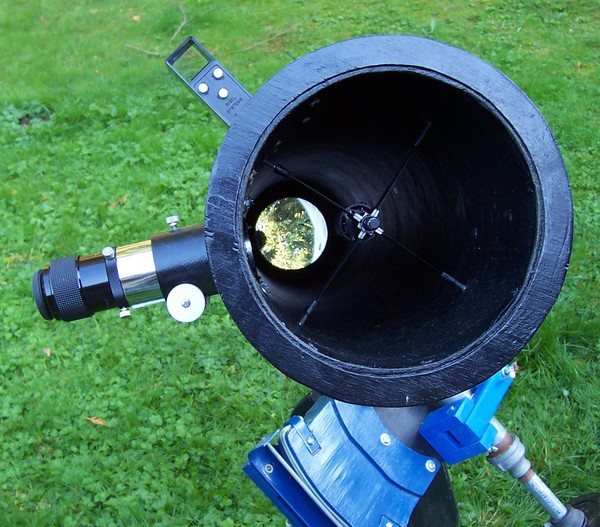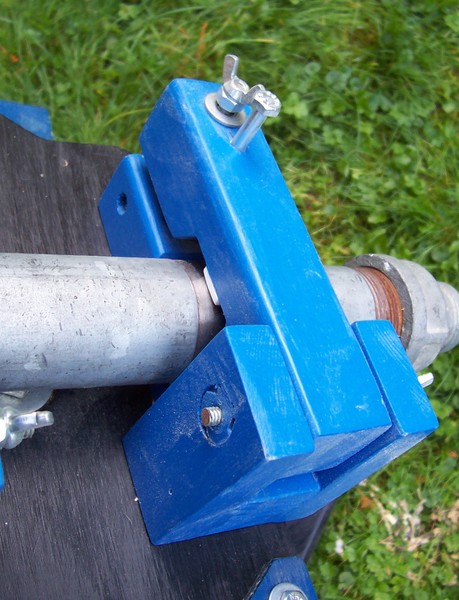
Home Telescopes Mirror Making Contact Site Map
Home --> Telescopes --> 6 inch German Eq

I built this telescope back in 1986 based on the design in Richard Berry's book Build Your Own Telescope. I build the pedestal part of the mount in eighth grade shop class, probably one of the more unusual projects chosen by a student! I spent countless nights looking at planets, galaxies, and nebulae with this telescope. Over the years I made several modifications which I describe below.
Although I had big plans in mind for using the telescope for astrophotography, I only got as far as some piggyback photography.
 |
 |
 |
| The mirror end of the OTA. Push-pull bolt pairs are used to collimate the primary mirror. | Looking down the tube. The Novak spider is a bit of a pain to adjust. | One of the pillow blocks. |
The German Equatorial mount is constructed mostly of 3/4" plywood. The RA axis is a 1/2" bolt with a large Formica bearing surface. Polar alignment is accomplished with three pairs of push-pull bolts. The declination is a 2 1/2" galvanized pipe with large custom pillow blocks have teflon bearings and adjustable tension. The counterweights are barbell weights from a sporting goods store.
The drive system is based on a worm gear segment with a 1 RPM motor. All the components are very low-tech (affordable for the high school student I was at the time). The worm gear itself consists of two adjacent 1/4-20 threaded rods bent into an arc, driven by a straight threaded rod attached to the motor (Sky and Telescope, July 1989, p. 100). The whole drive system is attached to the RA axis via a piece of plywood sandwiched between the two existing RA bearing disks.
The 1 RPM motor itself is driven by a simple circuit containing an LM317T voltage regulator. The circuit came from Sky and Telescope, possibly "Regulating the Voltage of a DC Motor" on p. 198 of the Aug 1987 issue (I don't have the issue - I checked it out from the library years ago). A potentiometer in the circuit allows precise adjustment of the motor speed. The hand control has two buttons which can be used for guided photography, or for centering an object in the field of view; one button speeds up the motor as long as it is held down, and the other slows down the motor.
I also put together a makeshift fine control for the declination axis, not shown in the photographs. It was a manual control, with a knob the could be rotated. I used it for photography only, because it was inconvenient (even more than the RA drive) to use for visual observing.
Being my first telescope, there were many things I would do differently if I were to start again from scratch. For one, I probably won't ever make a German Equatorial mount again unless I am blessed enough to have a permanent location (i.e. observatory) for a telescope. The mount is heavy and awkward to carry from the garage out into the yard. It's big and has many components to put in the car when taking it on a trip. Unless you're doing photography, the Dobsonian mount is absolutely unmatched in convenience. As an aside, I did eventually tire of the heavy mount, and also built a Dobsonian mount.
The telescope wasn't designed from the ground up to contain a drive system, so the system is far from ideal. It has to be manually unclamped and then clamped again each time you move to a different object. The mount itself isn't quite smooth enough to attempt planetary photography, though the smoothness would probably be improved by beefing up the drive system. Finally, the segment section of the drive system puts the RA axis off balance; it should have a counterweight opposite the segment.